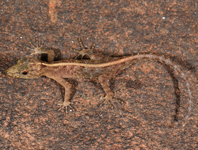Abstract
La Pampa province is divided into two clearly distinguishable fractions: a small northeastern humid sector corresponding to the Pampas ecoregion and a drier western sector, represented by the Monte de Llanuras y Mesetas (termed Monte region in this paper) and Espinal ecoregions (sensu Brown et al. 2006). These three ecoregions are visibly distinguishable from an edaphological and phytogeographic point of view, while the mammalian fauna composition is homogeneous. The study area was located in the central part of the province, comprising the Monte and Espinal ecoregions (Fig. 1). In that area three species of armadillos are recorded (Soibelzon et al. 2015). Two of these (Zaedyus pichiy Desmarest, 1804 and Chaetophractus villosus Desmarest, 1804) (Xenarthra: Chlamyphoridae) are the most common and widely distributed armadillos both in the province and in the country, while the third species, Chlamyphorus truncatus Harlan, 1825, has a more restricted distribution and is one of the most cryptic and least known armadillos in the country. For this reason, in our fieldwork ectoparasites were obtained only from the first two species mentioned.
References
Brown, A., Martinez Ortiz, U., Acerbi, M. & Corcuera, J. (Eds.) (2006) La Situación Ambiental Argentina 2005. Fundación Vida Silvestre Argentina, Buenos Aires, 587 pp.
Bush, A.O., Lafferty, K.D., Lotz, J.M. & Shostak, A.W. (1997) Parasitology meets ecology on its own terms: Margolis et al. revisited. Journal of Parasitology, 83, 575–583.
https://doi.org/10.2307/3284227
Del Ponte, E. & Riesel, M.A. (1939) Notas sobre Siphonaptera argentinos. Physis, 17, 543–551.
Ezquiaga, M.C. & Lareschi, M. (2012) Surface ultrastructure of the eggs of Malacopsylla grossiventris and Phthiropsylla agenoris (Siphonaptera: Malacopsyllidae). Journal of Parasitology, 98, 1029−1031.
https://doi.org/10.1645/ge-3062.1
Ezquiaga, M.C., Rios, T.A., Actis, E.A., Cassini, G.H., Abba, A.M. & Superina, M. (2020) Effect of host and environment-related factors on fleas of the pichi, an armadillo from Argentina. Anais da Academia Brasileira de Ciências, 92 (2), e20180656. https://doi.org/10.1590/0001-3765202020180656
Gallo, J.A., Poljak, S., Abba, A.M., Udrizar Sauthier, D.E., Camino, M., Torres, R.M., Tamburini, D.M., Decarre, J., Soibelzon, E., Castro, L.B. & Superina, M. (2019) Chaetophractus villosus. In: SAyDS-SAREM (Eds.), Categorización 2019 de los mamíferos de Argentina según su riesgo de extinción. Lista Roja de los mamíferos de Argentina. Available from: http://cma.sarem.org.ar (accessed 19 February 2020)
https://doi.org/10.31687/SaremLR.19.039
Guglielmone, A.A. & Nava, S. (2006) Las garrapatas argentinas del género Amblyomma (Acari: Ixodidae): distribución y hospedadores. Revista de Investigaciones Agropecuarias 35 (3), 135–155.
Hastriter, M.W. & Méndez, E. (2000) A review of the flea genera Hectopsylla Frauenfeld and Rhynchopsyllus Haller (Siphonaptera: Pulicidae). Proceedings of the Entomological Society of Washington, 102, 612–624.
Krasnov, B.R. (2008) Functional and evolutionary ecology of fleas. A model for ecological parasitology. Cambridge University Press, New York, 593 pp.
https://doi.org/10.1017/CBO9780511542688
Lareschi, M., Sanchez, J.P., Ezquiaga, M.C., Autino, A.G., Diaz, M.M. & Barquez, R.M. (2010) Fleas associated with mammals from northwestern Argentina, with new distributional reports. Comparative Parasitology, 77, 207–213.
https://doi.org/10.1654/4448.1
Lareschi, M., Sanchez, J.P. & Autino, A.G. (2016) A review of the fleas (Insecta: Siphonaptera) from Argentina. Zootaxa, 4103 (3), 239–258.
https://doi.org/10.11646/zootaxa.4103.3.3
Mauri, R. & Navone, G.T. (1993) Ectoparásitos (Siphonaptera y Acari) más comunes en Dasypodidae (Mammalia: Xenarthra) de la República Argentina. Revista de la Sociedad Entomológica Argentina, 52, 121–122.
Nava, S., Venzal, J., Gonzalez Acuña, D., Martins, T. & Guglielmone, A.A. (2017) Ticks of the Southern Cone of America. Diagnosis, distribution, and hosts with taxonomy, ecology and sanitary importance. Academic Press, London, 348 pp.
Reiczigel, J., Zakariás, I. & Rózsa, L. (2005) Bootstrap test of stochastic equality of two populations. The American Statistician, 59, 156–161.
https://doi.org/10.1198/000313005X23526.
Rothschild, M. (1992) Neosomy in fleas, and the sessile life-style. Journal of Zoology, 226, 613–629.
https://doi.org/10.1111/j.1469-7998.1992.tb07504.x
Rózsa, L., Reiczigel, J. & Majoros, G. (2000) Quantifying parasites in samples of hosts. Journal of Parasitology, 86 (2), 228–232.
https://doi.org/10.2307/3284760
Smit, F.G.A.M. (1972) On some adaptative structures in Siphonaptera. Folia Parasitologica, 19, 5–17.
Smit, F.G.A.M. (1987) An illustrated catalogue of the Rothschild fleas (Siphonaptera) in the British Museum (Natural History). Vol. 7. Malacopsylloidea (Malacopsyllidae and Rhopalopsyllidae). Oxford University Press, Oxford, 396 pp.
Soibelzon, E, Negrete, J., Ciai, D.N. & Depino, E.A. (2015) Re-descubriendo el espinal pampeano. Aves Argentinas N&C, 2015, 12–15.
Superina, M., Abba, A.M., Udrizar Sauthier, D.E., Gallo, J.A., Soibelzon, E., Rogel, T.G., Agüero, A.J. & Albrecht, C.D. (2019) Zaedyus pichiy. In: SAyDS-SAREM. Categorización 2019 de los mamíferos de Argentina según su riesgo de extinción. Lista Roja de los mamíferos de Argentina. Available from: http://cma.sarem.org.ar (accessed 19 February 2020)
https://doi.org/10.31687/SaremLR.19.041


